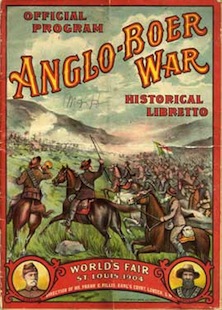 I’ve previously written about the odious racism of the 1904 World’s Fair in St. Louis, where various peoples from around the world were displayed like zoo animals. For the most part, these folks were asked to inhabit ersatz villages, so that their clothes and customs could be gawked at by paying customers. But some of the Fair’s international participants were instead cast as actors in a massive recreation of the Anglo-Boer War, which had concluded just two years prior. It was an enormous production, as a contemporary paper noted:
I’ve previously written about the odious racism of the 1904 World’s Fair in St. Louis, where various peoples from around the world were displayed like zoo animals. For the most part, these folks were asked to inhabit ersatz villages, so that their clothes and customs could be gawked at by paying customers. But some of the Fair’s international participants were instead cast as actors in a massive recreation of the Anglo-Boer War, which had concluded just two years prior. It was an enormous production, as a contemporary paper noted:
The Anglo-Boer war exhibition at the World’s Fair, St. Louis, in which General Croje is the leading figure, is the largest and most realistic outdoor entertainment ever seen. It is as though 20 acres of South frica had been carried across the Atlantic and dumped down at St. Louis…
A representation of the capture of Colonel Long’s guns at Colenso is shown. Men and horses drop until hardly one is left standing, deeds of heroism are performed, stray horses gallop wildly about. At last, with a loud cheer, the Boers, led by General Ben Viljoen, rush from rocks and kopjes, and the day is won…
The entertainment is a military tournament on a large scale, and one is brought face to face with war and all its horrors.
I was initially struck by the extreme oddness of this production, given how conflict’s freshness. It’s one thing for Civil War reenactors to take part in mock battles that are well over a century old, quite another to recreate a war that had ended two years earlier. Vietnam War reenactment might be a better comparison, but that pastime didn’t start until a good decade after the fall of Saigon. And it’s never been put on as a mass entertainment; instead, it is largely for the enjoyment of the participant themselves.
One might be tempted to say that folks of the early 20th century were more inclined to view warfare as spectator sport, but I’m not sure that’s what’s going on here. We have to keep in mind that in the pre-newsreel era, Americans who weren’t directly involved in warfare knew about the terrible practice solely through the written word (and, perhaps, the oral histories passed down by Civil War vets in their families). Think about that for a second—you’re fully aware that much of world history has been shaped by violent conflict, but you have never witnessed even a close approximation of the phenomenon. Curiosity is only natural.
There is obviously something a wee bit unsettling about the notion of turning recent conflict into theater—tough to envision folks lining up to see the 2008 campaigns in Afghanistan recreated in a major American city. We turn instead to film and television to get our warfare fix, but the focus there is now more on the interior lives of soldiers than the logistics of battle. That’s partly because contemporary warfare is chaotic, but also due to the fact that we’ve developed more empathy for the men and women who pay the price for officers’ orders—at least if those men and women are wearing friendly uniforms. We want to know how they cope with an experience that we understand to be shattering in so many ways; back in 1904, spectators were far more interested in the grandeur of General Cronje’s uniform.


ADW // Dec 20, 2010 at 4:10 pm
Aww, but we do like reenactments. Instead of witnessing them live, we have movies, and video games. And, yes, there’s story, but there’s lots of blood and gore to quench our appetites.
Oh, how we wish we were different, and more civilized, cultured, and less racist.
Jordan // Dec 20, 2010 at 11:53 pm
It also wasn’t too long after the days of Will Bill’s extravaganzas. We’ve got a certain amount of history of that kind of event here in America.